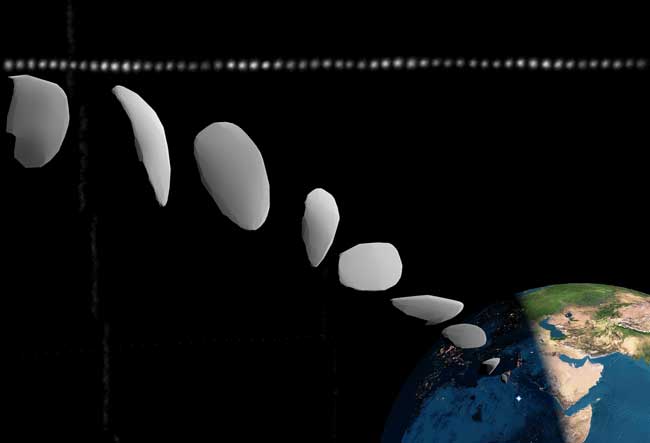Shape of Small Asteroid that Hit Earth Revealed

Theasteroid that crashed in northern Sudan last year was shaped like a loaf ofwalnut-raisin bread, according to astronomer Peter Scheirich and colleagues atOndrejov Observatory and Charles University in the Czech Republic.
Scheirichreported his findings at the Division forPlanetary Sciences of the American Astronomical Society meeting in Puerto Rico on Oct. 5, 2009 in a specialsession dedicated to this asteroid one year after the fall. The smallasteroid, designated "2008TC3", was the first to have been spotted in space beforehitting Earth.
LastDecember I traveled to Sudan. With the help of Sudan astronomer Muawia Shaddad,and 45 students of the University ofKhartoum, we went to the crash site in the Nubian Desert and recovered 300fragments (called meteorites) by carefully sweeping the gravely desert. Wefound many different looking meteorites, slightly south of the calculatedimpact trajectory.
We now havea gigantic jigsaw puzzle on our hands, from which we try to create a picture ofthe asteroid and its origins. Now, Scheirich and colleagues have provided uswith a composite sketch of the culprit, cleverly using the eyewitness accountsof astronomers that saw the asteroid sneak upon us.
Anirregular shape and rapid tumbling caused Asteroid 2008 TC3 to flicker when itreflected sunlight on approach to Earth. Astronomers Marek Kozubal and RonDantowitz of Clay Center Observatory in Brookline, Massachusetts, tracked theasteroid with a telescope and captured the flicker of lightduring a two-hour period just before impact. Scheirich combined theseobservations with others to work out the shape and orientation of the asteroid.
Otherforensic evidence, which was presented during the special session at theAAS/DPS meeting, chaired by Jason S. Herrin of NASA Johnson Space Center and me, is based on analysis of the recovered meteorites. These are of an unusual"polymict ureilite" type. Herrin confirms that the meteorites stillcarry traces of being heated to 1150-1300 ?C, before rapidly cooling down at arate of tens of ?C per hour, during which carbon in the asteroid turned part ofthe olivine mineral iron into metallic iron. Hence, Asteroid 2008 TC3 is theremains of a minor planet that endured massive collisions billions of yearsago, melting some of the minerals, but not all, before a final collisionshattered the planet intoasteroids.
MikeZolensky of NASA's Johnson Space Center first pointed out that, as far asureilites are concerned, this meteorite is unusually rich in pores, with porewalls coated by crystals of the mineral olivine. He now reports from X-raytomography work with Jon Friedrich of Fordham University in New York, thatthose pores appear to outline grains that have been incompletely weldedtogether and the pore linings appear to be vapor phase deposits. According toZolensky, "2008 TC3 may represent an agglomeration of coarse- tofine-grained incompletely reduced pellets formed during impact, andsubsequently welded together at high temperature."
Breaking space news, the latest updates on rocket launches, skywatching events and more!
The carbonin the recovered meteorites is one of the most cooked of all known meteorites.Carbon crystals of graphite and nano-diamonds have been detected. Still, itturns out that some of the organic matter in the original material survived theheating. Amy Morrow, Hassan Sabbah, and Richard Zare of Stanford University have found polycyclic aromatic hydrocarbons in high abundances. Amazingly, MichaelCallahan and colleagues of NASA Goddard Space Flight Center now report thateven some amino acids have survived.
To findmore puzzle pieces, Muawia Shaddad and I plan to re-visit the scene of thecrash in the Nubian Desert on the one-year anniversary of the find thisDecember 6-7, after sharing notes during a 2008 TC3 Workshop at the University of Khartoum.
- Closer Look at Asteroid 2008 TC3, Part 2
- Asteroid Exploded in Earth's Atmosphere
- Image Gallery - Asteroids
Peter is a distinguished Dutch-American astronomer and senior research scientist at the Carl Sagan Center of the SETI Institute and at NASA Ames Research Center. He is a noted expert on meteor showers, meteor falls, and artificial meteors who also wrote the books "Meteor Showers and Their Parent Comets from 2006 and "Atlas of Earth's Meteor Showers from 2023. He's a graduate of Leiden University where he obtained his M.S. and Ph.D.
